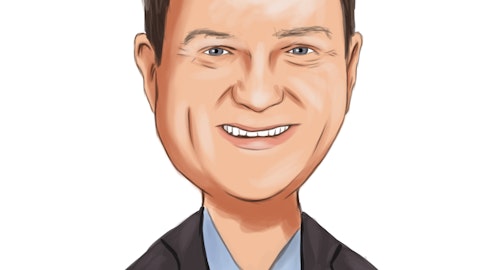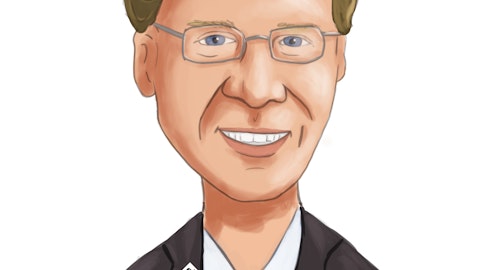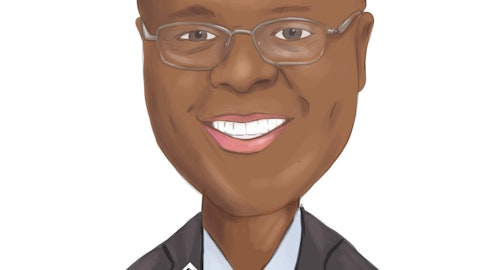Enterprise Financial Services Corp (NASDAQ:EFSC) Q4 2022 Earnings Call Transcript January 24, 2023
Operator: At this time, I would like to welcome everyone to the Enterprise Financial Services Corp. Fourth Quarter 2022 Earnings Conference Call. Thank you. I will now turn the call over to Jim Lally, President and CEO. You may begin.
Jim Lally: Colby, thank you and thank you all very much for joining us this morning and welcome to our 2022 fourth quarter earnings call. Joining me this morning is Keene Turner, EFSC’s Chief Financial Officer and Chief Operating Officer; and Scott Goodman, President of Enterprise Bank & Trust. Before we begin, I would like to remind everybody on the call that a copy of the release and the company presentation can be found on our website. The presentation and earnings release were furnished on SEC Form 8-K yesterday. Please refer to Slide 2 of the presentation titled Forward-Looking Statements in our most recent 10-K and 10-Q for reasons why actual results may vary from any forward-looking statements that we make today. Throughout 2022, we stressed our commitment to building partnerships with our clients, the execution of our strategic initiatives and our diversified business platform.
This cadence of consistency produced record results for both the fourth quarter and for the entire year. The financial highlights for the fourth quarter begin on Slide 3. We capped the year with tremendous momentum, both for loan growth as well as earnings. We earned $1.58 per share for the fourth quarter which resulted in a 1.83% return on average assets and a 23% return on tangible common equity. This is inclusive of our tangible common equity to tangible assets ratio expanding during the quarter and we closed the year at 8.43%. Additionally, our robust earnings helped to contribute approximately $2 per share to our tangible book value during the fourth quarter which closed at $28.67 per share. Turning to Slide 4. You can see that we had an outstanding quarter with respect to loan growth.
On an annualized basis, we were able to grow the loan portfolio by 16%. Moreover, the diversification on which we have focused was on full display as just about every market in business line contributed to these outstanding results. Scott will provide much more color about these markets and businesses in his comments. Our posture on deposits has not changed. We continue to actively manage deposit rates and focus on the relationship aspect of this side of our business. The goal is to find the appropriate balance between retention, growth, competitiveness and stability. I’m really pleased with how this has played out as evidenced by the De minimis amount of runoff, a relatively low cost of total deposits and a stable DDA percentage right around 42%.
This level of discipline, coupled with the rise in short-term interest rates resulted in a net interest margin expansion of 56 basis points. Our credit statistics remain outstanding as both non-performing loans to total loans and non-performing assets to total assets improved from the very low levels that we reported at the end of the third quarter. We did record a modest provision expense in the quarter due to our strong loan growth outpacing the risk reduction in the portfolio during the fourth quarter. Slide 5 provides a recap of our highlights for the full year. On a fully diluted basis, we earned $5.31 per share in 2022 an increase of 38% from 2021. We grew portfolio loans at a rate of 11% for the year, with contributions from all of our regions and businesses.
Along with our balance sheet performance, this growth supported our record financial results. Our pre-provision net revenue expanded 25% over the prior period. This helped drive a pre-provision net revenue return on average assets that easily surpassed 2% to end 2022. All in all, 2022 was an incredible year for EFSC. We entered the year with a focused mindset of delivering consistent results. The record earnings per share that we produce is a product of a well-executed plan that focused on diversified revenue growth, disciplined pricing within our deposit base, consistent credit and pricing fundamentals, patient and thoughtful capital and investment management and responsible expense management. As we turn the page and head into 2023, our areas of focus which are found on Slide 6 have not changed.
Despite the continual change of our operating environment which include ongoing short-term rate increases, intense deposit competition and the likelihood of a mild recession, we are confident of our ability to perform at the high level that we have become accustomed to. The conversations we’ve had with our clients gives us confidence that 2023 should be another outstanding year for EFSC. For the most part, backlogs and order books of the operating companies that we serve are strong with corporate balance sheets that provide ample room for continued growth. They are still dealing with some of the same issues that have become commonplace such as sufficient competent labor and reliable supply chains. However, we do not see these issues as derailers to the success of these businesses.
We feel good about the continued growth of our investor CRE business due to the many projects that have broken ground in late 2021 and throughout 2022. New projects have been slower to materialize as the sharp rise in interest rates require the owner developers to recalibrate their input metrics inclusive of additional equity. On the deposit side of things, we believe that we will continue to see a bit of pressure on rates throughout the year. There’s always a lag on rate increases, especially for higher balance commercial accounts. We’ve been hard at work throughout much of 2022 identifying specifically where we need to make proactive movements to preserve these highly valued relationships and feel very good about where they stand. With that said, I feel very confident that we can fund our expected loan growth with the various deposit generators that we currently have.
With that, I would like to turn the call over to Scott Goodman, President of Enterprise Bank & Trust for his insights about our markets and business lines. Scott?
Scott Goodman: Thank you, Jim and good morning, everyone. As you’ll see on Slide number 7, loans at year-end totaled just over $9.7 billion, representing an 11.3% increase from the prior year, net of PPP. Although, $984 million of core growth was well diversified across the major loan categories as detailed on Slide number 8. Strong growth in C&I reflects continued success in attracting new operating company relationships across our footprint. Specialty business lines contributed a similar level of growth overall as C&I and also continue to perform consistently. Growth in commercial real estate, while more modest overall generally reflects an intentional approach to partner and go deeper with a select set of strong investors and developers in each market rather than chase projects or transactions.
Q4 was a period of strong loan growth as reflected on Slide number 9 with contributions by nearly all markets and lines of business. Originations for the quarter were up nearly 15% from the prior period. Q4 is typically a seasonally strong loan production quarter for us but this was further bolstered by wins on a number of larger new C&I relationships and nice performance out of the gate by our new team in Dallas. The specialty lending units contributed roughly 1/3 of the growth this quarter with an aggregate increase of $141 million. SBA finished strong, posting growth of $43 million in the quarter despite the continuing headwinds of higher short-term rates. The team is focused on proactive steps to moderate payoff activity with existing borrowers and continued consistency in our product offering to the market with a relatively stable pipeline heading into 2023.
Life insurance premium finance had a seasonally strong quarter, based on the timing of premium renewals in the book. But growth has been further accelerated by additional new referral partners in 2022, including new opportunities from the legacy First Choice book which we’ve been able to nurture and grow. Tax credit also executed well with $52 million of quarterly growth, pushing the total to $73 million or 15% for the year. Strong quarter mainly reflects advances on the existing projects in process along with several new ones. The necessity for affordable housing and the continued adoption of these programs by more states should provide continuity of our opportunity pipeline in this business looking forward. Sponsor Finance posted a small decline in the portfolio for the quarter, mainly relating to slightly lower origination activity and some churn in the existing book through to the sale of platform companies.
Year-over-year growth for this business has been quite strong at $127 million or 25%. Much of the activity in this channel is timing contingent due to the aspects of the M&A process and the lower origination volume reflects some delayed closings which will carry over into Q1. In general, though, the pipeline of new deals for the specialty remains healthy and active. Turning now to the regional results which are on Slide 10. Our Midwestern markets of St. Louis and Kansas City grew $99 million in Q4 and posting year-over-year growth of 9.4% both markets experienced a modest increase in revolving line outstandings and had solid new origination activity in the quarter. Notably, we onboard several new middle market C&I relationships along with a nice volume of refinance and new commercial real estate development loans in the Kansas City market.
Our Southwestern markets grew by $81 million for the quarter, resulting in solid year-over-year growth of 14.6%. This includes $27 million in growth from our new Texas team, bringing their production to $43 million for 2022. This office which opened midyear is off to a strong start and with a nice balance of both new C&I and commercial real estate clients. The Arizona team also had some nice closing this period including a large retail center for a new investor relationship and a development loan for a large, well-known community-based organization serving children in the Phoenix Metro under a new market tax credit structure. In Southern California, we grew $51 million in the quarter and are building nice momentum heading into 2023. We continue to execute a strategy in this market of expanding the legacy relationships from predecessor banks and developing a larger C&I portfolio through talent acquisitions.
This period, we onboarded several new C&I relationships, assisted a large legacy franchise operator with an acquisition and materially expanded a credit facility with a legacy CRE investor. Moving now to deposits which are on Slides number 11 and 12. Total deposit balances were down $229 million for the quarter and $515 million or 4.5% year-over-year. Breaking this down, non-interest-bearing accounts were stable for the quarter and up year-over-year. The declines were really isolated to the interest-bearing categories, with the majority of the funds being a limited number of higher cost transactional accounts or idle balances of larger businesses. As you heard from Jim, we’ve taken an intentional approach of selectively managing our deposit pricing to prioritize retention, deepen our key relationships and attract new ones.
We’ve also developed a number of competitive deposit options for clients and our bankers are having proactive conversations to mitigate outflows. The deposit breakdown on Slide number 13 provides some clarity by region. Larger impacts tend to be within our more concentrated C&I markets and legacy portfolios. In the Midwest, for example, a large portion of their $281 million decline for the quarter is attributable to a single upper middle market company that we had assisted with a Main Street loan. Upon recent repayment of the Main Street loan, we were unable to retain the full relationship which moved back to a national bank along with the accompanying deposits of roughly $120 million in the quarter. More generally, though, we have been successful in growing relationship-based balances, originating over $1 billion of deposits from new relationships during the year, with average balances for these new accounts, materially exceeding those in closed accounts.
Lastly, I’d like to point to the growth of our specialty deposit verticals which are detailed on Slide number 14 and which continue to enhance our flexibility to optimize our funding strategy. During Q4, balances grew within each of our specialties, community associations, property management and third-party escrow. Specialized deposits in aggregate grew $102 million in the quarter and $302 million or 13.6% for the year. Now, I’d like to turn the call over to Keene Turner for further financial highlights. Keene?
Keene Turner: Thanks, Scott and good morning, everyone. My comments begin on Slide 15, where we reported earnings per share of $1.58 in the fourth quarter on net income of $60 million. Organic growth in earning assets and continued margin expansion drove a meaningful increase in operating revenue in the fourth quarter. This led to record earnings per share that expanded 20% from the third quarter. Non-interest expense and the provision for credit losses both increased in the quarter but these increases were more than offset by the 16% sequential increase in operating revenue. For full year 2022, we reported net income of $203 million and earnings per share of $5.31 compared to $3.86 in the prior year. Turning to Slide 16. Net interest income for the quarter was $139 million compared to $124 million in the linked quarter, an increase of $15 million.
The increase came as a result of higher average loan balances, along with the benefit of increasing interest rates, driving our asset yields higher. The increase in net interest income was primarily driven by a $21 million increase in loan income and was partially offset by a $6 million increase in deposit expense. With the current composition of our balance sheet as of December 31, we expect the full impact of the existing interest rate increases will result in a quarterly net interest income in the range of $143 million to $146 million. As noted in the earnings release, approximately 17% of the variable rate loan portfolio reprices on the first day of each quarter and did not benefit from the fourth quarter interest rate increases. We expect that with the Fed reducing the magnitude of interest rate increases, that first and second quarter actions will be largely offset by lagged deposit costs.
We’re experiencing better-than-expected pricing on interest-bearing deposits. However, we do expect that we will continue to address deposit costs and competition in 2023. That is to say that net interest income growth will be correlated with loan growth and any additional actions by the Fed. Moving on to Slide 17, net interest margin on a tax equivalent basis was 4.66%, an increase of 56 basis points from the linked quarter. With an asset-sensitive balance sheet, we continue to benefit from rising rates and asset yield rose more than liability costs in the period. Earning asset yields improved 78 basis points which included 77 basis points of loan yield improvement, including a 6.64% origination rate on new loans and the investment yield improved 26 basis points as reinvestment rates continue to increase to a 5.2% fourth quarter tax equivalent rate.
Asset yields were also aided by an enhanced asset mix as we continue to grow loans and investments while reducing cash balances. The cost of interest-bearing liabilities increased 40 basis points from the prior period, driven mainly by higher deposit rates and variable rate borrowings. Our deposit portfolio remains more than 40% non-interest-bearing balances which allows us to be more deliberate with deposit pricing compared to prior rate cycles. The loan portfolio is our largest driver of asset sensitivity as 63% of loans are variable rate. More than 60% of those have interest rate floors. And essentially, all of those with floors are currently priced above the floor. While our variable rate loans have enhanced earnings during this cycle, we executed several interest rate swaps in the fourth quarter to protect future earnings if rates should begin to move in the opposite direction.
Our interest-bearing deposit beta was approximately 30% in the fourth quarter. And while it is higher than the previous period in 2022, it remains below our expected and historical level. While we expect this lag in the deposit pricing to abate, we believe our ability to control deposit costs through this rising rate environment has been greatly enhanced versus prior interest rate cycles. We remain committed to funding asset growth through relationship-based deposits and our specialty verticals. On Slide 18, we demonstrate our credit trends. Annualized net charge-offs remained low at 9 basis points in the fourth quarter compared to 2 basis points in the linked quarter. For the full year, net charge-offs were $3.9 million or 4 basis points compared with $11.6 million or 14 basis points in the prior year.

Investments, Finance
Overall, asset quality improved in the quarter with non-performing assets and non-performing loans declining in dollar and percentage terms, from both the linked quarter and the prior year-end. Non-performing assets were 8 basis points of total assets and non-performing loans were 10 basis points of total loans. In addition to the improvement in the non-performing category, we also experienced a decline in past due loans in the quarter. On Slide 19, we demonstrate the allowance for credit losses. The allowance for credit losses declined $3.6 million in the quarter to $137 million, primarily due to net charge-offs and the overall improvement in asset quality. While the economic forecast factors used in our CECL model generally worsened in the fourth quarter, the loan portfolio mix shifted to areas that carry a lower reserve.
A provision expense of $2.1 million was recognized in the quarter which primarily reflects an increase in the reserve for unfunded commitments. The allowance for credit losses represents 1.41% of total loans compared to 1.5% at the end of the third quarter. When adjusting for government guaranteed loans, the allowance to total loans was at 1.56% at the end of December. Turning to Slide 20. Our fourth quarter fee income was $17 million, an increase of $7 million in the quarter. The increase was led primarily by a $6 million increase in tax credit income. As you recall, this line item was negatively impacted in the third quarter by rising interest rates on tax credit projects carried at fair value while fourth quarter results did not see the same negative impact as rates were steady in the quarter and benefited from seasonally strong sales of tax credits.
Tax credit income will continue to be seasonal and subject to further interest rate movements. However, fair value adjustments that reduced tax credit income are more than offset by higher net interest income in a rising interest rate environment. The fourth quarter also saw fees earned on community development investments compared to the linked quarter increase and they were partially offset by a decrease in deposit service charges driven primarily by an increase in earnings credits to clients based on recent interest rate trends. Turning to Slide 20. Fourth quarter non-interest expense was $77 million, an increase of $8 million compared to $69 million in the third quarter. Deposit service expenses were the main driver and increased $6 million from the linked quarter due to rising interest rates and growth in certain specialized deposit businesses.
Compensation and benefits increased $1.2 million from the linked quarter, principally from higher performance-based incentive and bonus accruals due to the company’s strong financial results. The fourth quarter’s core efficiency ratio was 48.1%, an improvement of 170 basis points compared to the third quarter. This reflects the continued momentum in operating revenue, outpacing the rise in non-interest expense during the quarter. Looking to 2023, we’re expecting the core efficiency ratio to be in the 50% to 51% range as we expect to see margin expand further from our fourth quarter levels. First quarter trends typically include an expected seasonal decline in fee income as well as higher compensation expense. Overall, for 2023, we expect salaries and benefits to increase around 6% and from the fourth quarter annualized run rate.
The next big driver of expense is from increased deposit service expense from both rate and growth in certain specialized deposit businesses. We view this space as competitive and evolving and there may be some opportunity for us to manage throughout the year but not necessarily in the next couple of quarters. Our efficiency ratio guide reflects our posture on how we expect this line item to trend in 2023. Our capital metrics are shown on Slide 22 and the record earnings we generated in the fourth quarter of $60 million combined with an improvement in accumulated other comprehensive income, resulted in tangible book value per share of $28.67, an increase of 8% from the third quarter. During 2022, we still increased tangible book value per share by roughly $0.40 with our strong earnings level while returning $67 million to common shareholders through dividends and share repurchases.
We announced another increase to our dividend for the first quarter of 2003, marking the seventh consecutive quarter of the dividend has been increased. In 2022, we paid common dividends of $0.90 per share a $0.15 increase or 20% compared to the prior year. While our dividend has increased, our dividend payout ratio of 17% in 2022 remains at a level that provides flexibility in our capital structure moving forward. The tangible common equity to tangible asset ratio improved to 8.4% at the end of the year. After the initial decline in the first quarter, when market interest rates increased and negatively impacted accumulated other comprehensive income, the tangible common equity ratio has improved in each of the last 3 quarters. While the tangible common equity ratio is now within our target range of 8% to 9%, we do not plan to execute any meaningful share repurchases in the near term.
With the uncertainty on the path of interest rates and the potential economic impact of further short-term rate increases, we intend to let our organic earnings further strengthen our capital base. When market conditions and our capital position align, we still have 2 million shares available under our Board-approved purchase program. We had great momentum throughout the year and finished 2022 with a strong quarter. We delivered a 23% return on tangible common equity and a 1.8% return on average assets in the fourth quarter with a 19% return on average tangible common equity and a 1.5% return on average assets for the full year 2022. We believe that we are well positioned and look forward to carrying this momentum in 2023. Thank you for joining the call today and we’ll now open the line for analyst questions.
See also 15 Biggest Import-Export Companies in the World and 10 Best Stagflation Stocks To Buy.
Q&A Session
Follow Enterprise Financial Services Corp (NASDAQ:EFSC)
Follow Enterprise Financial Services Corp (NASDAQ:EFSC)
Operator: Your first question come from the line of Jeff Rulis from D.A. Davidson.
Jeff Rulis: Yes, I just wanted to kind of get a sense for the variable deposit costs. Keene, we got your kind of high-end guardrails on efficiency and expectations on margin and how that all flows through. But just wanted to narrow in on the variable deposit costs. Is that sort of a onetime catch? Is that seasonal in nature? I know you had referenced kind of rate driven but is there anything kind of year-end? Just trying to predict that line a little bit better and how that — from a run rate perspective?
Keene Turner: Sure, Jeff. I’m happy to give you some color there. So there was a little bit of catch-up that was in there from year-end and it really related to a competitive decision we made in the fourth quarter. Obviously, everybody is fighting for liquidity now. And I think the specialized deposit space is one where we’re seeing some of the key players there. They’ve had some major deposit outflows and really trying to get aggressive. So we’re just holding our ground there. I think we had a good quarter in terms of balances and we were responsive to some competitive pressures that had a little bit of an effect on some of what was earned throughout the year and there was some catch-up. I would say going forward, when you look at 4Q to 1Q sequentially, we’re thinking that, that line item is up maybe $2 million to $3 million, just depending on what happens with balances and rates and sort of everything that we know at the end of the year.
So maybe based on December run rate itself, it’s probably $2 million. And then, based on growth and maybe some more leakage from a competition perspective, that increases up to $3 million sequentially. And then I think if you layer that in with our efficiency ratio guide, I think you can kind of see how we think that plays out for 2023.
Jeff Rulis: Okay. If I catch that right, you’re referencing the variable deposit cost line item specifically and that’s in addition to the…
Keene Turner: Yes, yes.
Jeff Rulis: And then we got your salaries and comp in Q1 commentary as well. So it looks like an up in Q1 but again, kind of use that efficiency ratio to back in for the full year?
Keene Turner: Yes. I think Q1 obviously won’t compare to the 48% efficiency with the seasonal fee income and a little bit shorter day count from a net interest income perspective and you have some seasonal expenses there. But I think with that $2 million to $3 million for the first quarter sequentially on that, tax credit line — or sorry, the ECR line item, that should give you some good starting points for modeling the expenses for 1Q.
Jeff Rulis: Okay. I wanted to jump over to the margin? I think you referenced putting on some swaps in the quarter, I can’t remember if that’s the first we’ve heard of that. I mean just trying to get a sense for have you been putting those on in quarters prior and/or just trying to get the strategy of — are you trying to be more aggressive in moderating or locking in, again, margin to the downside, should we flip on rates? Just trying to sense for the appetite of could we see more? And how far do you go? Obviously, clearly benefiting on the asset sensitivity front but I want to see what the other side and what you plan to do into ’23?
Keene Turner: Yes. Jeff, I think — so certainly, we were — we’ve been focused in ’23 on various strategies to essentially take some asset sensitivity off the balance sheet. Initially, I think that was cash into securities. And I think just moving the loan to deposit up in and of itself did that to a degree with soaking up some of that excess liquidity and letting some of that go. And then once rates were up, what we would say is meaningfully, call that late second quarter, early third, we started looking at a hedging strategy to take somewhere between 50 and 100 basis points of asset sensitivity to the downside off the table. I’d say we’re about halfway there. We’ve done a couple of hundred million so far and we might have $200 million to $300 million to go.
We’re not getting — we’re not going to be incredibly aggressive. We would have liked to be maybe a little bit more assertive earlier on putting the hedges on but quite frankly, the loan hedges move the same direction as the fair value of securities in comprehensive income. And so that was a guardrail that caused us to be a little bit more cautious. So now with TCE in a little bit better spot, we’re layering some of those in. And with the way the rate curve is, those are probably shorter-term hedges but we’re not going to take 3% sensitivity off the table. We’re probably going to take the better part of 100 basis points and we’ll probably end up sitting there. So that’s the way we’re thinking about it. And then all of our net interest income and margin guidance is reflective of that, that we provided on my comments earlier.
Operator: Your next question comes from the line of Damon DelMonte from KBW.
Damon DelMonte: So first, I want to kind of continue on the margin commentary there. So Keene, do you think you guys kind of peak here in the first quarter for your margin? And then kind of are able to defend it and hold it as you progress through ’23? Or do you think you still see a rise as far as the second quarter of this year?
Keene Turner: Yes. I think based on my comments, I think that seemed to reflect more defensive with first quarter peak, I think, when you really look out at how we forecasted it. I think that margin on a monthly basis peak sometime in the third quarter but I’m not saying that, that would actually result in third quarter margin being higher than second. And again, that’s all dependent on what — when we get the 7 basis points of Fed funds increases ” that we’re expecting to get, if that’s all layered into the first quarter, then obviously, second quarter is probably more like the peak. But if that’s a little bit more drawn out, I think maybe the peak is lower but maybe it’s later. So we’re thinking about it, call it, June, July time frame in terms of peak and probably first to second quarter is when you get what you guys will see as peak margin.
Damon DelMonte: Got it. Okay. That’s helpful. And with regards to the outlook for loan growth, can you just provide a little color on what the expectation would be for next year. the commentary seemed pretty positive. Do you think you could kind of replicate the level you had in ’22? Or do you think we start to see a bit of a pullback?
Jim Lally: Yes, Damon, this is Jim. I’ll handle that. We’re very comfortable in the mid- to high single-digit number with everybody contributing we talked about the fact that we don’t want to jump into transactional lending or do the last project in any market. Just keep to the game plan, then we’re going to have quarters like we had in the fourth quarter when it all comes together but we’re comfortable that mid- to high single-digit growth going forward.
Damon DelMonte: Great. And then do you guys — do you do much in the office space in your commercial real estate portfolio?
Jim Lally: Scott, do you want to talk about that?
Scott Goodman: Yes. Damon, it’s I wouldn’t say it’s a focus. It’s a function of those relationships that I talk about in each of our markets. But it’s not a large focus or a concentration for us. And I think the portfolio we do have it seems to be performing well. Generally, it’s like neighborhood type offices. We don’t have a large metro Class A type portfolio.
Damon DelMonte: Got it. And are you able to quantify the percentage of overall loans or of the CRE portfolio?
Scott Goodman: Yes.





